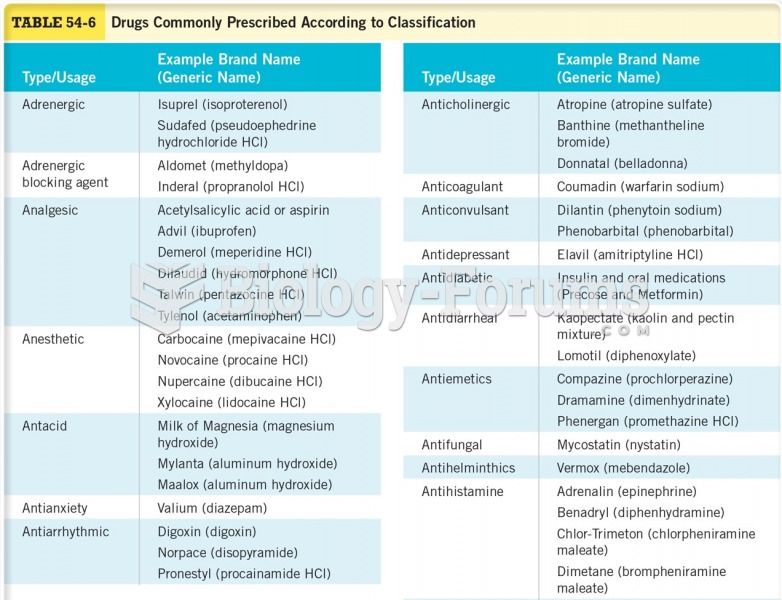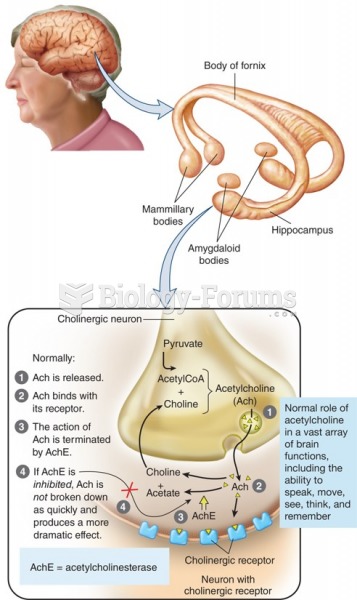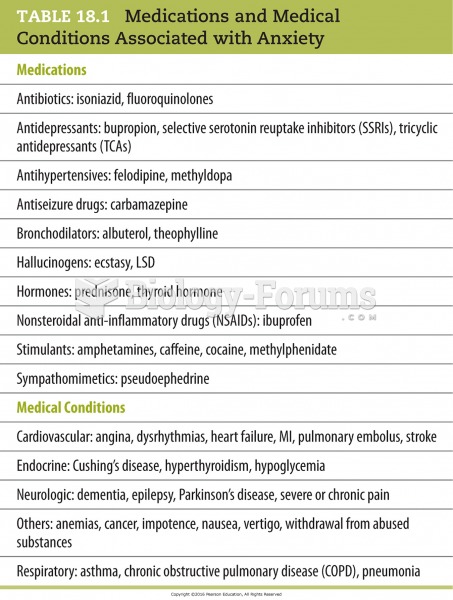Answer to Question 1
Medication Indications/Mechanism Nutritional Concerns
Capoten/ captopril Antihypertensive (angiotensin-converting enzyme ACE inhibitor) Take on empty stomach
Take oral Fe or Mg supplement separately by at least 2 hr
Al-Mg antacids/supplements decrease absorption (take separately)
Possible anorexia, wt loss
Limit alcohol
Metallic or salty taste
Decreases K excretion; may cause hyperkalemia
Erythropoietin Synthetic hormone that stimulates synthesis of RBC Increases appetite
Diet compliance mandatory in CKD
Increases BP
GI distress
Sodium bicarbonate Normalize blood pH High in sodium
Take Fe supplement separately, 1 hr before or 2 hr after drug
Increased thirst
Increased weight (edema)
Renal caps Replace vitamins lost in dialysis GI irritation
N/V
Take after dialysis
Renvela Phosphate binder used in CKD Low-phosphorus diet
Nausea
Dyspepsia
Diarrhea
Constipation
Flatulence
Severe decrease in GI motility
Low serum phosphorus, calcium
Hectorol Synthetic vitamin D2 (doxercalciferol); used to treat hypocalcemia in dialysis patients Do not take with vitamin D or magnesium supplement
Increases calcium absorption
Glucophage Antihyperglycemic agent (biguanide) Take with meals
Nausea/vomiting, bloating
Diarrhea
Flatulence
Avoid alcohol
Hypoglycemia
Answer to Question 2
Potassium (high): Serum potassium levels may be elevated post-surgery or could be an acid-base imbalance. It is most likely a result of post-operative status.
CPK (high): CPK is an enzyme found in muscle tissue. When there is muscle damage, CPK levels may be elevate. This high concentration is likely a post-operative response.
Glucose (high): Because of uncontrolled type 2 diabetes. Obesity contributes to uncontrolled blood glucose levels and obesity is a major risk factor for type 2 diabetes. Glucose values will probably decrease with significant weight loss.
HbA1c (high): Average blood glucose over 8-12 weeks. High due to uncontrolled diabetes. High blood glucose allows for more hemoglobin to be glycated with glucose. May improve or be lowered with weight loss and improved glycemic control.
HDL (low): Obesity and some genetic profiles are positively associated with dyslipidemia, which would explain low HDL levels. HDL (high density lipoproteins) remove cholesterol from the body tissues and bring it back to the liver. Lower weight could potentially increase physical activity, as well, leading to increases in HDL.
LDL (high): Obesity is associated with hyperlipidemia, which is why the cholesterol or lipid profile numbers are out of range. An alteration in lipid metabolism occurs in obesity, which may decrease the activity of the lipogenic enzyme that down-regulates LDL receptors. Lipid profiles tend to be normalized as individuals reach a more optimal weight.
Triglycerides (high): Sources of serum triglycerides are either from dietary intake (transported by chylomicrons from the intestine) or from endogenous production by the liver. High serum levels will be either from excessive dietary fat and simple sugars or from an increased production and/or decreased clearance of lipoproteins transporting the triglycerides.).
Cholesterol (high): Same reasoning as LDL and other lipid profile values. Value will probably decrease once weight loss is achieved.







